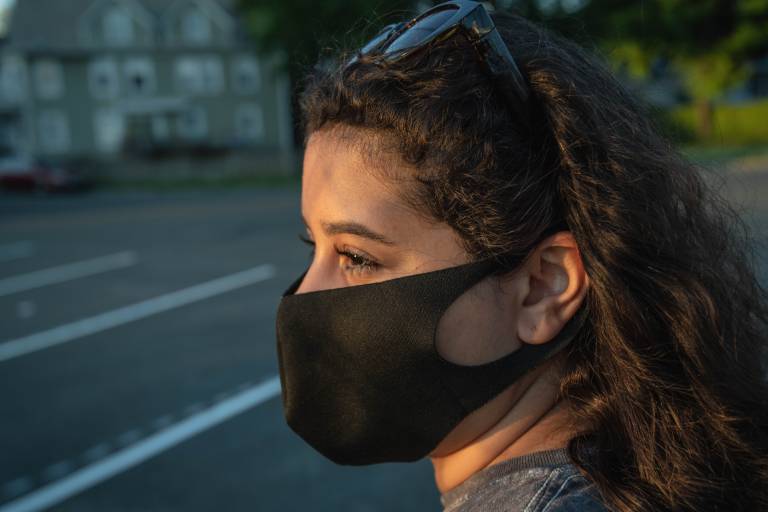All kinds of problem behaviors, such as criminal behavior, school bullying, and substance abuse, have constantly decreased during the 2000s. So why do more and more people need treatment?
Mental disorders during the developmental phase of adolescence
The developmental phase of adolescence begins with puberty and ends with the consolidation of structures of an adult personality. On average, on a populational scale, adolescence takes place between the ages of 13 and 22, but individual differences in puberty and the whole developmental stage can be great.
The production of sex hormones starts during puberty, which causes a physical development towards a biological sexual maturity, but also causes a strong developmental progress in the central nervous system. The structural and functional changes in the nervous system make it possible to develop more effective cognitive functions. On an emotional level, the start of adolescence includes an increase in mood swings and weaker emotional control compared to the end of the childhood phase, before emotional control can start to develop. These physical and psychological changes are accompanied by changes in social relationships and the social status of the adolescent. For adolescents, all fields of development are in motion.
Mental disorders are the most significant disorders for adolescents. They are responsible for 60–70% of adolescent conditions that cause lowered functioning, and even on a global level, five out of the ten most severe illnesses or disorders that cause lowered functioning are mental disorders, for example depression, behavioral problems, and substance abuse. Mental disorders are noticeably more common in adolescents than in children. This difference cannot be explained with any one cause, such as hormones; it is instead affected by many biological, psychological, and social causes. When everything is in motion, problems are also going to happen.
Adolescents are especially prone to risk-taking behavior, which might also produce traumatic experiences that make them more vulnerable to mental disorders.
Adolescents are especially prone to risk-taking behavior, which might also produce traumatic experiences that make them more vulnerable to mental disorders. Due to developments in the central nervous system, seeking experiences and rewards controls the behavior of adolescents before the ability to think of long-term consequences and delay the need for pleasure are developed. For this developmental phase, it is typical that the immediate social acceptance of peers is more rewarding than potential long-term safety and health benefits.
Services are more common, but they are not sufficient
On an international level, Finland has a unique system of adolescent psychiatric services, which can treat the psychiatric disorders of adolescents in a way that takes the special needs of their developmental phase into consideration. Hospital districts offer specialist level healthcare in the forms of non-institutional and institutional care. Additionally, in some cities, the mental disorders of adolescents can be treated in their own workgroups and student healthcare that are led by adolescent psychiatrists. All municipalities in Pirkanmaa have a service specifically for treating the mental disorders of adolescents. Work that promotes good mental health and prevents mental disorders in adolescents is also done in the services of social and child welfare, in schools, and in youth work, even if mental health is not the main purpose of these services.
Demand for adolescent mental health services has constantly increased during the 2000s, and this growth has only accelerated in the last five years. Between the 1990s and the 2000s, the number of patients in institutional healthcare has multiplied.
The resource used for treating the mental health of adolescents has been constantly increased in both special healthcare and basic services in Finland for decades. Additionally, during the 2000s, there have been constant efforts to prevent and give better treatment to the mental disorders of adolescents with the help of publicly funded programs, such as KASTE (in Finnish) and LAPE (in Finnish). Despite this, the demand for treating the mental disorders of adolescents is too high for these resources. Demand for adolescent mental health services has constantly increased during the 2000s, and this growth has only accelerated in the last five years. Between the 1990s and the 2000s, the number of patients in institutional healthcare has multiplied. For example, from the start of the 2000s to this day, the yearly number of adolescents that used adolescent psychiatric services at the Tampere University Hospital has tripled. Starting from 2015, there has been a 40% increase in referrals to special health care in adolescent psychiatrics. The number of institutional periods in adolescent psychiatrics has doubled, and the number of adolescents coming to institutional care has increased by 70%. In some health care districts, almost 10% of adolescents are currently receiving regular specialist-level health care from adolescent psychiatrics. At the same time, all kinds of basic services have also been filled with adolescents that need mental help. The same phenomenon has also been observed in other Western countries.
With the occurrence of severe mental disorders in adolescents, there has not been a similar trend of increase starting from the 1990s. Based on self-reports, adolescents have had an increase in depression and anxiety, but only in very recent years. All kinds of problem behaviors, such as criminal behavior, school bullying, and substance abuse, have constantly decreased during the 2000s. So why do more and more people need treatment?
Is everyday life becoming medicalized?
Medicalization refers to reinterpreting normal physical, psychical, or social phenomena as illnesses or disorders that should be treated in healthcare. Due to medicalization, the normal mood swings and boundary-breaking behaviors of adolescence could be seen, unlike in the past, as psychiatric symptoms or disorders that need treatment.
However, our analyses on the patient records of specialized healthcare do not indicate everyday medicalization. For example, from the start of the 2000s to the start of the 2010s, at the adolescent psychiatrics of the Tampere University Hospital, the symptom profiles of patients have stayed the same, despite the number of patients being doubled. Systematic analysis based on the demand in 2017 showed that many of the symptoms that indicate emotional instability, such as self-cutting, depression, anxiety, symptoms of psychosis, and impulse control problems, had become more common among new patients. In 2020, self-destructiveness has been the reason for institutional care in adolescent psychiatrics twice as often as it was five years ago.
From a population that has stayed fairly the same, more adolescents are now being funneled into special psychiatric health care than five, ten, or twenty years ago. They are showing symptoms more strongly than before. This raises the question if adolescents really are more ill than before, even if this has not yet been proven in epidemiological research, or if their living environments have changed in a way that makes more and more adolescents require psychiatric help, even if they themselves are the same as before.
The risk factors for the mental disorders of adolescents are not constantly increasing
There is no reason to assume that the process of neurobiological development in adolescence would somehow change over time. The possibility of puberty starting slightly earlier would only change the timing of adolescent development, not its nature. Because of this, we have to examine psychosocial and societal phenomena.
Finland is one of the safest and one of the best welfare countries in the world. Many of the factors that are important for the mental health of adolescents have changed for the better during the 2000s. Adolescents become the victims of crimes less often (in Finnish), corporal punishments (in Finnish) have reduced in homes, and the trends of alcohol consumption in adults (in Finnish) have also decreased, which allows us to assume that adolescents will at least not have to live their lives surrounded increasingly by a lifestyle of drinking. The alcohol consumption of underage adolescents has also decreased, and there has not been an increase in the use of illegal substances. As the 2000s has progressed, adolescents have reported in questionnaires that they have closer familial connections and better conversational connections with their parents. Fewer adolescents take part in school bullying. Experiences of sexual abuse in adolescents are decreasing, despite or maybe because more attention is being given to the harmfulness of sexual abuse than before. With these advances, it could be assumed that adolescents have an improved state of welfare.
New expectations, new challenges
At the same time, when more and more adolescents have come to the different levels of mental health care, there has also been an increase in the needs that adolescents have for child protective services and that elementary school children have for special and intensified support from teachers. If more and more adolescents cannot survive in their everyday lives without special support, it raises the question if everyday life has been tuned incorrectly? For example, have adolescents been given responsibilities for things that their abilities of self-control and emotional control are not sufficient for, even if their physical and cognitive abilities would suffice?
At least in schools, there are certain practices that have been known to be challenging even for first-year university students and burdening for adults, such as the responsibility to make choices (at an ever younger age) with long-term consequences, to work without supervision, and to do project-like work in changing, open spaces with changing co-workers. Universities replacing their entrance exams with selections based on school diplomas was meant to control the industry of cram schools and stress, but it has also transferred the stress to younger age groups with less complete personalities, and now cram schools are selling to lower secondary schools. Could a student ruin their life by making the wrong choices as young as at the age of 13?
Adolescents’ activities related to climate change attracted much attention before the corona pandemic, and many suspected that adolescents were having disorders due to the anxiety caused by climate change. However, adolescence is a time of idealism and activism. Being active against solutions that endanger the adolescents’ future is healthy and positive. Adolescents suffering from actual adolescent psychiatric disorders do not usually have the energy to participate in activism, which offers both a way to influence and experiences of belonging and team power. And it is not new to find phenomena worth engaging in activism, even though the phenomena are new.
The effects of social media are strongly present to be the reasons for adolescent depression and anxiety, instability, and self-destruction. It is needless to demonize social media too much. Keeping contact with the same friends that an adolescent also meets “live” at school and on their spare time through social media channels and apps is just a new kind of method for doing it. In the 1980s, families got into heated arguments on Saturday afternoons, when teens were about start their third phone marathon in the early evenings. Now it happens through other methods.
While a large majority of adolescents feel that the world of social media gives them joy and relaxation instead of stress and anxiety, in some ways, social media constitutes a new kind of risk factor.
The world of social media and the internet still has many dangers. Disturbing content is falling on the eyes of developing children and their guardians cannot prevent it. Bullying has significantly moved to the internet, where it can go on for 24/7 without anyone involved getting caught. The internet has many groups that encourage symptomatic behavior, such as morbid weight loss, provoking violence and hate, and self-destruction. Before the world of the internet and social media channels, it was hard to maintain these groups. Pressures for being attractive have reached an entirely new level since everyone look divinely perfect in their edited social media pictures. Unlike before, when the perfect people came from the distant circles of movies and music, the perfect people are now one’s own peers from the borders of one’s friend groups. While a large majority of adolescents feel that the world of social media gives them joy and relaxation instead of stress and anxiety, in some ways, social media constitutes a new kind of risk factor.
Stability and time are needed to build an identity
For adolescents, a typical psychological self-defense mechanism is splitting, along with idealization – devaluation. Adolescents are inclined to see things and people as either entirely good or completely worthless. A person they admire can become despised lightning fast. For an adolescent, it is hard to see things as different gradient shades of grey, black, and white. For an adolescent, it is harder than for an adult to accept that the same person can have both good and bad sides, that a loved one could have sides that they do not like, or that a mean person could also have good in them.
As a society, we end up seeing adolescents in a similarly black-and-white fashion that they see themselves. In our society, there are simultaneously both adolescents that are amazing, beautiful, smart, language-proficient, creative, and naturally gifted with computers, along with juveniles who are only causing problems, constantly taking more substances, becoming violent, and acting against societal order. For the former, we need to give more chances and power, and for the latter, we need to give harsher punishments. However, both extremes could disrupt adolescent development and lead to symptoms in the areas of emotional life and behavior, and to instability.
If an adolescent can recreate themselves every morning, day, and night, they also have to constantly fear that making one choice excludes other, potentially better options.
The identity of an adolescent is fragmented and contextual. Forming a permanent identity, which comes from one’s own initiative and that can endure changing circumstances, out of these fragments is the end product of successful adolescent development. In the old days, many had a path paved before them from birth. Family background and place of living determined what a child would later become, and many have cried, complained, and cursed about the narrowminded and predetermining developmental environments of their adolescence. The current problem, however, is excessive open-endedness. If an adolescent can recreate themselves every morning, day, and night, they also have to constantly fear that making one choice excludes other, potentially better options. And so, they can have no peace. They could always be better, more successful, and more popular. Our time can be described with the “fear of missing out” (FOMO). A constant need to grab in every direction simultaneously leads to the personality staying fragmented here and there, with emptiness between them. This is what instability is about.
A developing child needs a level of guidance and care that suits their current age and level of development. Testing boundaries is a typical part of adolescence. If these boundaries are not met, the adolescent is more likely to try harder.
Developing children should be given power to make decisions and rights to things and circumstances where they have the capacity to take responsibility for consequences and duties, but not any more than that. Difficult boundary-breaking or uncontrollable behaviors are caused by the fact that the care and guidance given to the adolescent have not been enough to allow for the ability and willingness to behave in a constructive manner that fits their age level. Neither the ability nor the motivation to control their own emotions and behavior can appear by shutting the adolescent out of adult supervision that should have already been more supportive, or their circle of peers, where adolescent development takes place in. I am in no way saying that, for example, adolescents that are acting violently should continue behavior that endangers the development of their peers. But the continuation of destructive behavior has to be stopped, prosocial solutions need to be made more attractive, and adolescents with developmental difficulties should be given ways to join the flow of normal development.
The boundaries being spread too much cannot be compensated by sending the adolescent to psychiatric care to be fixed, so that they could set their own boundaries afterwards.
The adolescent needs social skills so that they can constructively join their peers, have experiences of success in desirable activities instead of undesirable ones, physical and emotional support and stability, and experiences of being good enough. These things should primarily happen as a part of everyday life in the adolescent’s normal developmental environments. The boundaries being spread too much cannot be compensated by sending the adolescent to psychiatric care to be fixed, so that they could set their own boundaries afterwards.
Translation by Niko Randell. The translator is a Master’s-level student of Multilingual Communication and Translation Studies at Tampere University. The article was originally published in Finnish in October 2020.






